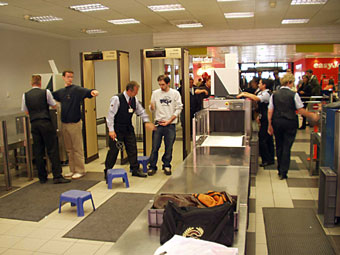Adding travel restrictions won’t keep us safe. It never has.
Groan.
Can homeland security officials really, really be this dumb?
From The New York Times:
According to a statement posted Saturday morning on Air Canada’s Web site, the Transportation Security Administration will severely limit the behavior of both passengers and crew during flights in United States airspace — restricting movement in the final hour of flight. Late Saturday morning, the T.S.A. had not yet included this new information on its own Web site.
“Among other things,” the statement in Air Canada’s Web site read, “during the final hour of flight customers must remain seated, will not be allowed to access carry-on baggage, or have personal belongings or other items on their laps.” …
Earlier in the day, British Airways had announced on its Web site that passengers flying from London to the United States would be allowed to carry only one item onto a plane.
These absurd actions, of course, come in response to the Nigerian who apparently tried to bring down an airplane for al-Qaida using a device employing powder strapped to his leg and a liquid in a syringe. It’s a familiar pattern: After Richard Reid introduced us to the phrase “shoe bomber” in 2002, we had to take off our shoes before boarding an airplane; when a bunch of guys in the U.K. tried liquid- or gel-based explosives, suddenly our gels and liquids had to be brought on board in smaller sizes, or get confiscated.
None of this has anything real to do with security, of course. At the risk of drawing the wrath of safety officials around the world, I’m going to explain how terrorists work, even though I’m not a terrorist myself: Whatever the restrictions are, they try something different.
There it is. You’re welcome. Now you can be ready for the next threat!
After Richard Reid ruined shoe-based terrorism for them, they moved on to nonshoe-based terrorism. After gels and liquids were made mildly more complicated for them, they moved on — if that phrase is even justified — to a mix of liquids and powders.
Now we can ban powders from planes, everything from mascara to hot chocolate mixes, but terrorists will find another explosive. We can restrict passengers’ movements in the last hour of flight, and terrorists will try to blow up planes at some other time. We can limit carry-ons to one piece, and the terrorists will bring their explosives aboard in it.
We can ban any number of legitimate passenger privileges and rights on airplanes, and terrorists will still have trains, malls and buildings to attack.
What’s most telling about our nonsensical, lame, too-little, too-late efforts at homeland security is that the things we respond to never actually worked in the first place. The gel and liquid explosives never got used, because the plot was exposed early. The shoe bomber’s shoe bomb wouldn’t light. The latest device sucked, too. These aren’t the devices to ban — they’re the ones the terrorists should keep using as a way to keep the rest of us safe. If we keep banning the lame stuff, eventually the terrorists are going to find something that actually explodes.
What actually ended the threats of Reid and Abdul Farouk Abdulmutallab, the Nigerian, were their fellow passengers, who have an interest in arriving at their destination safe and alive. Homeland Security can’t prevent terrorism no matter how many rules they put in place, but they can count on airline passengers to act when they must.
(By the way, The U.S. Transportation Security Administration doesn’t have a leader — Sen. Jim Demint, Republican of South Carolina, is holding up the appointment of Erroll Southers over a collective-bargaining dispute. While it’s almost certain Southers will continue his predecessors’ moronic exclusions of items and additions of rules, we can hope he’s better than that.)

